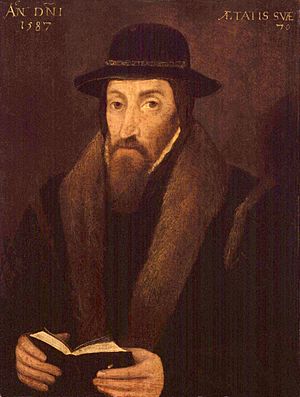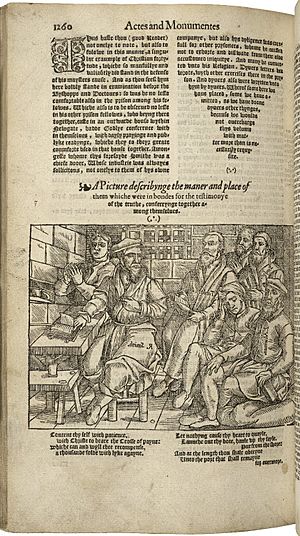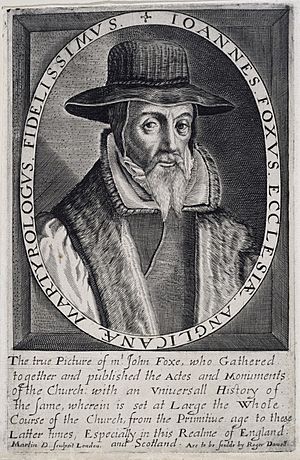John Foxe facts for kids
Quick facts for kids
John Foxe
|
|
|---|---|
 |
|
| Born | 1516 Boston, Lincolnshire, England |
| Died | 1587 (aged 69–70) London, England |
| Occupation | Clergyman, author |
| Genre | Church history |
| Literary movement | Puritan |
John Foxe (born 1516 or 1517 – died 18 April 1587) was an English historian and writer. He is most famous for his book Actes and Monuments, often called Foxe's Book of Martyrs. This book tells the stories of Christian martyrs throughout history. It especially focused on the suffering of English Protestants during the 14th century and the reign of Queen Mary I. The book was very popular with English Puritans and greatly shaped how people in Britain viewed the Catholic Church for many years.
Contents
Early Life and Education
John Foxe was born in Boston, Lincolnshire, England. His family was quite well-known. He seemed to be a very serious and religious child who loved to study.
Around 1534, when he was about 16, he went to Brasenose College, Oxford. He later joined Magdalen College School. He became a fellow there, which meant he was a senior member of the college.
Foxe earned his first degree in 1537 and his master's degree in 1543. He also taught logic at the university. Letters from this time show that Foxe was a friendly and religious person. He was very keen to meet other scholars. By the time he was 25, he had studied many important texts and learned Hebrew.
Leaving Oxford University
In 1545, Foxe left his college. This happened because he became a Protestant. At that time, under King Henry VIII, the Church of England did not allow these beliefs. Foxe might have been forced to leave during a clear-out of Protestant members. However, college records say he resigned on his own.
Becoming a Protestant put Foxe's life in danger. He even saw someone named William Cowbridge burned for his beliefs in 1538. After leaving his promising university career, Foxe faced hard times. He became a tutor for the family of Thomas Lucy. On 3 February 1547, Foxe married Agnes Randall. They had six children together.
Life in London Under Edward VI
Things got better for Foxe and other Protestants when Edward VI became king in 1547. The new king's advisors supported Protestant ideas. Foxe moved to London around 1547.
He worked on translating Protestant sermons. He also found a supporter in Mary Fitzroy, the Duchess of Richmond. She hired him to teach her brother's children. These children included Thomas, who later became a duke and a good friend to Foxe.
Foxe was ordained as a deacon in 1550. He became friends with many important Protestant leaders. One close friend was John Bale, who encouraged Foxe to write his first book about martyrs.
Life in Exile During Mary I's Reign
When Mary I became queen in July 1553, things changed again. Queen Mary was a Catholic and began to persecute Protestants. Foxe lost his tutoring job. He felt threatened by Bishop Stephen Gardiner.
To escape arrest, Foxe and his pregnant wife sailed from Ipswich to Nieuwpoort in Belgium. He then traveled through Antwerp, Rotterdam, and Frankfurt. By July 1554, he reached Strasbourg. In Strasbourg, Foxe published a Latin history of Christian persecutions. This book was an early version of his famous Acts and Monuments. It also helped create the image of Queen Mary I as "Blood Mary."
In late 1554, Foxe moved to Frankfurt. He became a preacher for English refugees there. He got caught up in a disagreement among Protestants about church rules. Foxe supported John Knox, who was later expelled. In 1555, Foxe and about twenty others also left Frankfurt. Foxe disliked the arguments, even though he agreed with Knox.
Foxe then moved to Basel, where he worked as a proofreader. He also wrote a religious play in Latin called Christus Triumphans (1556). Even with some help from English merchants, Foxe was very poor during this time.
When Foxe heard about the persecution in England, he wrote a pamphlet. He asked the English nobles to use their power to stop the killings. His plea did not work.
Returning to England
After Queen Mary I died in 1558, Foxe did not rush back to England. He waited to see what religious changes Queen Elizabeth I would make. Foxe was also too poor to travel with his family until money was sent to him.
Back in England, he lived for ten years with his former student, Thomas Howard. Foxe began working with printer John Day. He published religious books while working on his new book about martyrs, the Actes and Monuments.
Foxe became a priest, but he had some Puritan beliefs. He did not like wearing the special clothes (vestments) that the queen's rules required. Many of his friends followed the rules, but Foxe was more stubborn. He was not interested in using his powerful friends to get a better job.
Actes and Monuments
Latin Editions of Foxe's Book
Foxe started writing his Book of Martyrs in 1552. This was before the worst persecutions under Queen Mary I began. In 1554, while he was in exile, Foxe published an early Latin version of his book. This version focused on the persecution of the English Lollards in the 15th century.
As news of the English persecutions reached Europe, Foxe gathered more information. He wanted to continue his story up to the present day. He published the first full Latin edition of his famous book in Basel in August 1559. It was hard to write about current English history while living far away in Germany. But Foxe, who had left England poor, returned with a good reputation because of his Latin work.
First English Edition Published
On 20 March 1563, Foxe published the first English edition of Actes and Monuments. It was printed by John Day. This was a huge book, about 1800 pages long. It was three times longer than the 1559 Latin version.
The book's full title was very long, but people usually called it Acts and Monuments or Foxe's Book of Martyrs. Publishing this book made Foxe instantly famous. He became "England's first literary celebrity." However, he did not earn much money from it. The book sold for more than ten shillings, which was three weeks' pay for a skilled worker. This book became the second most popular book written in English, after the Bible.
Second Edition and Criticisms
Actes and Monuments was immediately criticized by Catholics. They called it names and said it was full of lies. To make his book stronger against these criticisms, Foxe prepared a second edition. He also had lots of new information that came out after the first edition was published.
In the second edition, published in 1570, Foxe removed parts that were not accurate. Where he could prove his critics wrong, he strongly defended his work. Even though he removed some parts, the second edition was almost twice the size of the first. It had 2300 very large pages.
The English church liked this new edition. In 1571, church leaders ordered that a copy of the Bishops' Bible and Monuments of Martyrs be placed in every cathedral. They also said church officials should have copies in their homes. This was very good for Foxe's printer, John Day, who had taken a big risk printing such a large book.
Later Editions and Accuracy
Foxe published a third edition in 1576, which was similar to the second. The fourth edition came out in 1583. This was the last edition published during Foxe's lifetime. It was also very large, with about two thousand pages. This book was nearly four times longer than the Bible. It was one of the biggest and most complex books printed in England at that time.
Foxe based his stories of early martyrs on earlier writers. For the English martyrs from the Lollard period through Mary I's reign, Foxe used many original sources. These included trial records and eyewitness accounts. This helped to connect Catholicism with cruelty in English minds.
Foxe's accounts are more accurate when he writes about his own time. However, he chose what information to include. He was not completely neutral. Sometimes he copied documents exactly. Other times, he changed them to fit his purpose. Foxe's way of using sources shows he was honest and wanted to find the truth.
However, Foxe sometimes made small mistakes. He also did not believe in being neutral, as historians do today. He often added his own strong opinions in the margins of his text. For example, he wrote things like "Mark the silly shows of these little popes." Despite some criticisms, Foxe's book is very detailed and contains much firsthand information about the English Reformation that cannot be found anywhere else.
Life Under Queen Elizabeth I
Work in Salisbury and London
Foxe dedicated Acts and Monuments to Queen Elizabeth I. In 1563, he was given a special church position at Salisbury Cathedral. This was to honor his support for the English church. Foxe never visited the cathedral or did any duties there. He kept the position until he died.
By 1565, Foxe was involved in a debate about church clothing. He was on a list of "godly preachers" who refused to wear traditional church robes. He was one of twenty clergymen who asked to be allowed not to wear vestments.
Around 1569, Foxe moved out of Thomas Howard's house and into his own home. This might have been because he was worried about Howard's bad choices. Howard tried to marry Mary Stuart, which led to him being put in the Tower. Foxe visited Howard in prison and was there at his execution in 1572.
In 1570, Foxe gave an important sermon at Paul's Cross in London. This sermon explained Protestant beliefs and criticized the Catholic Church. Seven years later, another sermon by Foxe caused trouble. The French ambassador complained to the Queen that Foxe had supported the right of French Protestants (called Huguenots) to fight their king. Foxe explained that he meant they would stop fighting if the French king did not let the Pope rule over him.
In 1571, Foxe helped edit an edition of the Anglo-Saxon gospels. This book showed that having the Bible in the common language was an old custom in England.
Death and Lasting Impact
John Foxe died on 18 April 1587. He was buried at St. Giles's, Cripplegate church. His wife, Agnes, likely died in 1605. Foxe's son, Samuel Foxe, became successful after his father's death. He also saved his father's writings, which are now in the British Library.
Foxe's Personality and Character
Foxe loved books so much that he sometimes hurt his health by studying too much. But he was also very good at making friends. He often gave spiritual advice and helped people in need. He was even known to help people find partners for marriage.
Foxe was so well-known for his prayers that Francis Drake believed Foxe's prayers helped him win a battle at Cadiz. People also thought Foxe had special powers, like being able to predict the future or heal the sick.
Foxe truly hated cruelty. When some Flemish Anabaptists were sentenced to be burned in 1572, Foxe wrote letters to the Queen asking for their lives to be spared. He also wrote to the prisoners themselves, asking them to change their beliefs. Foxe even visited them in prison. Sadly, his efforts did not work, and two of them were burned.
Richard Day, the printer's son, knew Foxe well. In 1607, he described Foxe as an "excellent man" who worked very hard. He said Foxe's knowledge was "inferior to none of his age." He also called Foxe "a bright light" for his honest life. Many people attended Foxe's funeral.
Historical Reputation of Foxe's Book
After Foxe's death, Acts and Monuments continued to be published and read. It was a huge influence on English Protestant thinking for many years.
Because the book was used to criticize Catholicism, its accuracy was questioned in the early 1800s. Some critics said it was full of made-up stories. However, later studies have shown that Foxe's work is more accurate than some critics claimed.
Modern scholars now have a more balanced view of Acts and Monuments. Foxe was like a lawyer arguing a case. He had to use real evidence, and he rarely made things up. But he would not include facts that hurt his side. He was skilled at arranging information to support his point of view. So, while Foxe's book gives important evidence, it should always be read knowing that he had a strong opinion.
See also
 In Spanish: John Foxe para niños
In Spanish: John Foxe para niños
- Jean Crespin
- John Foxe's apocalyptic thought
- Religion in the United Kingdom



